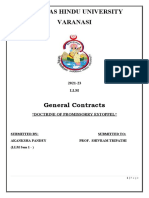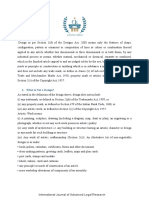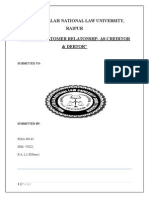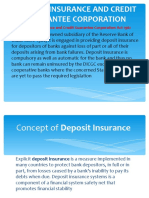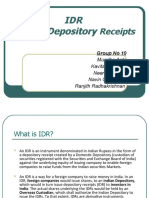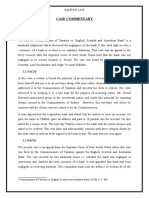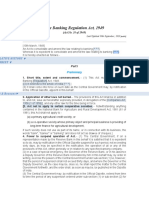And Corporatisation of Stock Exchanges in India
And Corporatisation of Stock Exchanges in India
Uploaded by
Shashank JoganiCopyright:
Available Formats
And Corporatisation of Stock Exchanges in India
And Corporatisation of Stock Exchanges in India
Uploaded by
Shashank JoganiOriginal Title
Copyright
Available Formats
Share this document
Did you find this document useful?
Is this content inappropriate?
Copyright:
Available Formats
And Corporatisation of Stock Exchanges in India
And Corporatisation of Stock Exchanges in India
Uploaded by
Shashank JoganiCopyright:
Available Formats
Business Law Project
MEANING AND INTRODUCTION
According to the Securities Contracts (Regulation) Act, 1956, Stock Exchange is an association,
organization or body of individuals, whether incorporated or not, established for the purpose of
assisting, regulating and controlling business in buying, selling and dealing securities.
Demutualisation refers to the process whereby a mutually owned financial institution, for e.g. a
stock exchange, is being converted into a stock company. Members usually receive shares in the
new company and in some cases a cash windfall, in exchange for their ownership rights.
Corporatisation means stock exchange should be organized as a company. The idea is to separate
ownership, management and trading rights from each other.
Example: An example for the same would be the demutualisation and corporatization of the Bombay Stock
Exchange to Bombay Stock Exchange Ltd.
i.
ii.
iii.
Before the scheme BSE was an Association of Persons and then after the scheme it
became BSE Ltd. i.e. a limited company.
Before the scheme both membership right and right to trade were held by the trading
members only. Before demutualisation took place the 790 broker-members held 100% of
the BSE.
After the scheme of Corporatisation and Demutualisation, ownership and membership
right have been segregated.
Historically, stock exchanges all over the world were mutual organizations owned by and run for
the common benefit of their members, with no member taking profits. They were like "clubs"
where the dealers transacted business through the open outcry system. Indian stock
exchanges(except NSE and OTCEI) followed a mutual structure where the ownership and
management rights of the exchange are bundled with trading rights as a broker and all three are
represented by ownership of share of the exchange.
The disadvantage of such organization is that they primarily work towards the interest of
members and not those of investors. The office bearers will have access to inside information
which can be misused by them. There is clear conflict of interest. There is transparency and no
professional approach. Moreover, they cannot raise large funds for modernization or up gradation
by offering equity shares to others.
In view of this short comings of such mutual stock exchanges, a policy decision has been taken
by Indian Government for corporatisation of stock exchanges, by which ownership, management
and trading memberships of stock exchanges would be separated from each other.
The Stockholm Stock Exchange was the first exchange to demutualize in 1993.
1
Business Law Project
FACTORS AND EVENTS
Factors leading to the Demutualisation and Corporatisation of Stock Exchanges in India:
The conflict of interests between the owners, the members and the management since all the
brokers are managing the exchange together
Investors interest was ignored as brokers were manipulating the market for their own
advantage
Scams took place in pre-demutualization phase-1992- Harshad Mehta scam & 2001-Ketan
Parekh Scam.
Lack of strict vigilance on the market-No one person or management was there to look after
the affair of the exchange.
--------------------------------------------------------------------------------------------------------------------Chronological Series of Events leading to Demutualisation and Corporatisation of Stock
Exchanges in India:
In 2001, Finance minister pledged on the floor of the parliament to demutualise all Indian
Exchanges
SEBI appointed Kania committee to look in to the various issues relating to Demutualisation
including questions relating to broker ownership
Kania Committee submitted its report to SEBI in August, 2002. Kania committee reports
essential recommendations:
i.
Three stakeholders namely shareholders, brokers and investing public to be equally
represented.
ii.
Disbursal of majority shareholding post demutualisation to non-brokers.
iii.
Concept of converting part of reserves of the exchange into deposit from brokers and
issuance of shares
iv. Consolidation of exchanges recommended
v. No Government internationally has claimed any compensation for fiscal benefits given to
exchanges prior to demutualisation
BSE submitted its duly approved scheme to SEBI in June 2003.
Amendments to Rules and MOA and AOA also submitted in July 2003(based on Kania
committee report) to SEBI for approval.
All required amendments in SCRA, Indian Stamp Act and Income Tax Act were then done.
Government asks for demutualisation of regional stock exchanges in two ways:
i.
Either by becoming trading arms of BSE & NSE, or
ii.
Number of regional stock exchange joins hands to make a separate platform
Business Law Project
NEW SEBI REGULATIONS
SEBI had issued directions on 10/1/2002 that no stock broker shall be an office bearer of stock
exchange i.e President, Vice-president, Treasure etc.
SEBI issued its guideline on 31- 11- 2006 for investment in stock exchanges in India. Under
these guidelines, shareholdings of trading Members have to be brought down to 49% which can
be either by divestment or additional equity capital to be issued to make the shareholding of
existing trading members to 49%. Therefore, it can be way of: i.
ii.
iii.
Offer for sale by prospector by existing trading members
Placement of shares of shareholders having trading rights to such persons or institutions
may be short listed by the exchange with the approval of SEBI.
Issue of equity shares on private placement basis by the stock exchange to any person or
group of persons not having trading rights subject to approval of SEBI.
--------------------------------------------------------------------------------------------------------------------Limitations: i.
ii.
iii.
iv.
No person shall directly or indirectly acquire or hold more than5% in the paid up capital.
No person shall either individually or together with persons in concert with him acquire
and or hold more than 1% of the paid up capital.
Foreign investment up to 49% will be allowed in stock exchanges with a separate FDI
cap of 26% and FII cap of 23%.
No FII shall seek and get representation on the Board of Directors of stock exchanges. No
foreign investor including persons acting in concert will hold more than 5% of the equity
in the exchange.
Business Law Project
CASE STUDY
Harshad Mehta Scam (1992): The making of the 1992 security scam
They took advantage of the many loopholes in the banking system and drained off funds from
inter-bank transactions. Subsequently, they bought huge amounts of shares at a premium across
many industry verticals causing the Sensex to rise dramatically. The exposure of Mehta led banks
to start demanding their money back, causing the Sensex to plunge.
The 1992 security scam and its exposure
"The crucial mechanism through which the scam was effected was the ready forward (RF) deal.
The RF is in essence a secured short-term loan from one bank to another. Crudely put, the bank
lends against government securities just as a pawnbroker lends against jewellery. The borrowing
bank actually sells the securities to the lending bank and buys them back at the end of the period
of the loan, typically at a slightly higher price. It was this ready forward deal that Mehta and his
accomplices used with great success to channel money from the banking system."
--Sucheta Dalal, The Times of India (April 23, 1992)
In a ready-forward deal, a broker usually brings together two banks for which he is paid a
commission. Although the broker does not handle the cash or the securities, this was not the case
in the prelude to the Mehta scam. Mehta and his associates used this RF deal with great success
to channel money through banks.
The securities and payments were delivered through the broker in the settlement process. The
broker functioned as an intermediary who received the securities from the seller and handed
them over to the buyer; and he received the check from the buyer and subsequently made the
payment to the seller. Such a settlement process meant that both the buyer and the seller may not
even know the identity of the other as only the broker knew both of them. The brokers could
manage this method expertly as they had already become market makers by then and had started
trading on their account. They pretended to be undertaking the transactions on behalf of a bank to
maintain a faade of legality.
Mehta and his associates used another instrument called the bank receipt (BR). Securities were
not traded in reality in a ready forward deal but the seller gave the buyer a BR which is a
confirmation of the sale of securities. A BR is a receipt for the money received by the selling
bank and pledges to deliver the securities to the buyer. In the meantime, the securities are held in
the sellers trust by the buyer.
Complicit lenders
4
Business Law Project
Armed with these schemes, all Mehta needed now were banks which would readily issue fake
BRs, or ones without the guarantee of any government securities. His search ended when he
found that the Bank of Karad (BOK) and Metropolitan Co-operative Bank (MCB) two small and
little known lenders, were willing to comply. The banks agreed to issue BRs when required.
Once they issued the fake BRs, Mehta passed them on to other banks who in turn lent him
money, under the false assumption that they were lending against government securities. Mehta
used the money thus secured to enhance share prices in the stock market. The shares were then
sold for significant profits and the BR retired when it was time to return the money to the bank.
Outcome
Mehta continued with his manipulative tactics, triggering a massive rise in the prices of stock.
Upon the exposure of the scam, several banks found they were holding BRs of no value at all.
Mehta had swindled the banks of Rs 4,000 crore. The scam came under criticism in the Indian
Parliament, leading to Mehta's eventual imprisonment.
Ketan Parekh Scam (2001): All my lifetime's savings are gone. I don't know how to feed my family."
- A small investor hit by the Ketan Parekh scam, in April 2001.
Making of the Scam: Almost everyone was eager to entrust their money with Parekh, which, he in turn used to inflate
stock prices by making his interest obvious. Almost immediately, stocks of firms such as Visual
soft witnessed meteoric rises, from Rs 625 to Rs 8,448 per unit. However, this fraudulent scheme
did not end with price rigging. The rigged-up stocks needed dumping onto someone in the end
and KP used financial institutions such as the UTI for this.
When companies seek to raise money from the stock market, they take the help of brokers to
back them in raising share prices. KP formed a network of brokers from smaller bourses such as
the Allahabad Stock Exchange and the Calcutta Stock Exchange. He also used share purchase in
the names of poor people living in Mumbais shanties. KP also had large borrowings from Global
Trust Bank and he rigged up its shares in order to profit significantly at the time of its merger
with UTI Bank. While the actual amount that came into Parekh's kitty as loan from Global Trust
Bank was reportedly Rs 250 crore, its chairman Ramesh Gelli is known to have repeatedly
asserted that Parekh had received less than Rs 100 crore in keeping with RBI norms.
Parekh and his associates also secured Rs 1,000-crore as loan from the Madhavpura Mercantile
Co-operative Bank despite RBI regulations that the maximum amount a broker could get as a
loan was Rs15-crore. Hence, it was clear that KPs mode of operation was to inflate shares of
select companies in collusion with their promoters.
5
Business Law Project
Notably, a day after the presentation of the Union Budget in February 2001, Parekh appeared to
have run out of luck. A team of traders known as the bear cartel placed sell orders on KPs
favorite stocks and crushed their inflated prices. Even the borrowings of KP put together could
not rescue his scrips. The Global Trust Bank and the Madhavpura Cooperative were driven to
bankruptcy as the money they had lent Parekh went into an abyss.
The exposure of the dupe
As with the Harshad Mehta scam, Ketan Parekh's fraudulent practices were first exposed by
veteran columnist Sucheta Dalal.
It was yet another black Friday for the capital market. The BSE sensitive index crashed another
147 points and the Central Bureau of Investigation (CBI) finally ended Ketan Parekhs two-year
dominance of the market by arresting him in connection with the Bank of India (BoI) complaint.
Many people in the market are not surprised with Parekhs downfall because his speculative
operations were too large, he was keeping dubious company, and he was dealing in too many
shady scrips.
-Sucheta Dalal, Times of India
When the prices of select shares started constantly rising, innocent investors who had bought
such shares believing that the market was genuine were about to stare at huge losses. Soon after
the scam was exposed, the prices of these stocks came down to the fraction of the values at
which they had been bought.
Dalal goes on to state that Parekh's scheme was not visible to a layman. Dalal added that KPs
arrest and similarity of his operations to securities scam of 1992 vindicated the miserable
inadequacy of the countrys regulatory system.
SEBIs damage control measures
SEBI investigations into Parekh's money laundering affairs revealed that KP had used bank and
promoter funds to manipulate the markets. The trading cycle was cut short from a week to a day.
SEBI formally introduced forward trading in the form of exchange-traded derivatives to ensure a
well-regulated futures market. It also did away with broker control over stock exchanges.
--------------------------------------------------------------------------------------------------------------------In both these cases, one can see complicity from insiders as a common factor. Both parties
conspired to defraud the common investor with their intimate knowledge and control of the
complex system. If the exchanges were not in their control but professionally run with proper
checks and balances perhaps we would, perhaps, have not seen these two major scams occurring.
The 2001 scam in particular speeded up the process.
Business Law Project
REASONS, CHALLENGES & RESISTANCE
Reasons why Demutualisation and Corporatisation is needed:
Rationalized Governance: - The corporate model will enable management to take actions that
are in the best interest of customers and the exchange itself. There would be transparency.
Investors Participations: - A demutualised exchange provides both institutional investors and
retail investors the opportunity to become shareholders. Institutional investors require much
greater liquidity for block trading.
Competition from Alternate Trading Systems (ATS) and Electronic Communication
Networks: - ATS and Electronic Communication Networks provide cheap and efficient
access to quoted stocks unlike traditional stocks exchanges. To cope with competition,
exchange required funds. While members have limitations in raising funds.
Globalization: - Historically brokers and exchanges were locally focused. Exchanges did not
face meaningful competition from exchanges in distance places. Through alliances,
exchanges seek to attract more investors by harmonizing distinct trading environment and by
offering greater product variety.
Resources for capital investment: - One of the drivers of stock exchange demutualization is
screen trading, which has replaced floor trading on most exchanges. Once customers have
direct access to screens, exchanges memberships no longer have as much economic value
and clearing firms rather than traders become a dominant force in exchange activities
--------------------------------------------------------------------------------------------------------------------Challenges of Demutualisation and Corporatisation:
There will be no changes in the conflict of interest if an exchange is converted from an
association of persons into a limited liability company
The same board and the same organizational structure will continue to exist and nothing
much will be achieved
The government cannot solve the exchanges management problem by steering the
demutualisation process
--------------------------------------------------------------------------------------------------------------------Resistance to Demutualisation and Corporatisation:
Though demutualisation is beneficial, many stock exchanges are hesitating to adopt it
because they are afraid of losing their identity
They also have the fear of paying huge tax conversions
This new revolution will become successful when the government will take the necessary
steps
7
Business Law Project
BIBLIOGRAPHY
Corporatisation and Demutualisation of Stock Exchanges: http://www.sebi.gov.in/commreport/demutes.html
What exactly is Demutualisation? Economic Times, January 21, 2002 http://articles.economictimes.indiatimes.com/2002-0121/news/27334241_1_demutualisation-trading-rights-brokers
Demutualisation of Stock Exchanges The Hindu, November 22, 2004 http://www.hindu.com/biz/2004/11/22/stories/2004112200371600.htm
BSE Demutualisation Complete Business Standard May 19,
2007 http://www.business-standard.com/article/markets/bse-demutualisation-complete107051901004_1.html
Corporatization - http://en.wikipedia.org/wiki/Corporatization
Demutualisation - http://en.wikipedia.org/wiki/Demutualization
You might also like
- SITHCCC012 - Prepare Poultry Dishes Worksheets: Section 1: Select IngredientsDocument5 pagesSITHCCC012 - Prepare Poultry Dishes Worksheets: Section 1: Select IngredientsChasing Dreams100% (2)
- Indian Capital Market and Regulatory FrameworkDocument9 pagesIndian Capital Market and Regulatory FrameworkAmitNo ratings yet
- Absolute, Relative, & Polar Coordinate EntryDocument3 pagesAbsolute, Relative, & Polar Coordinate EntryAmer Gonzales100% (1)
- Securiities Contract ActDocument25 pagesSecuriities Contract Acthema sri medi100% (1)
- Investment LawDocument6 pagesInvestment LawVarsha ThampiNo ratings yet
- Depositories Act, 1996 (Answer)Document3 pagesDepositories Act, 1996 (Answer)Debashish Sharma100% (1)
- Role of SEBI in Primary MarketDocument19 pagesRole of SEBI in Primary MarketTwinkle RajpalNo ratings yet
- IRDA Project - Akanksha - LLMDocument9 pagesIRDA Project - Akanksha - LLMPULKIT KHANDELWALNo ratings yet
- Role of Cci in Banking Mergers With Special Reference To Banking Law AmendmentDocument17 pagesRole of Cci in Banking Mergers With Special Reference To Banking Law AmendmentranjuNo ratings yet
- 10 Chapter 3.outputDocument33 pages10 Chapter 3.outputajith kumarNo ratings yet
- Rbi Fema PDFDocument22 pagesRbi Fema PDFPriyahemani100% (1)
- The Designs Act, 2000Document9 pagesThe Designs Act, 2000karthik kpNo ratings yet
- Reserve Bank of IndiaDocument17 pagesReserve Bank of IndiaShivamPandeyNo ratings yet
- Kinds of Banks and Their Functions: School of LAW Guru GhasidasDocument20 pagesKinds of Banks and Their Functions: School of LAW Guru GhasidasNilam100% (1)
- 6-Banking CompaniesDocument134 pages6-Banking CompaniesAnilNo ratings yet
- Regulatory PPT FinalDocument23 pagesRegulatory PPT Finaladitya sai0% (1)
- Project On Banker and CustomersDocument85 pagesProject On Banker and Customersrakesh9006No ratings yet
- Corporate Frauds Final DraftpreparationDocument52 pagesCorporate Frauds Final DraftpreparationSatinderNo ratings yet
- Preventive Measures by SebiDocument22 pagesPreventive Measures by SebiSwastikaRaushniNo ratings yet
- Banking Regulation Act, 1949: Project Report Submission On BankingDocument28 pagesBanking Regulation Act, 1949: Project Report Submission On BankingrajmalaleNo ratings yet
- ILODocument8 pagesILOJuliet MikeNo ratings yet
- CH 2 Banking Regulation ActDocument3 pagesCH 2 Banking Regulation Actpriyanka aroraNo ratings yet
- Fundamentals of Cyber LawDocument3 pagesFundamentals of Cyber LawxhetryNo ratings yet
- National Law University Odisha, Cuttack: Dissertation on-CORPORATE FRAUD - A CRITICAL AnalysisDocument7 pagesNational Law University Odisha, Cuttack: Dissertation on-CORPORATE FRAUD - A CRITICAL Analysisbeboo khanNo ratings yet
- Circular: October 08, 2020Document2 pagesCircular: October 08, 2020Rahul NairNo ratings yet
- Securities and Exchange Board of IndiaDocument34 pagesSecurities and Exchange Board of Indiadeffjamwezzstar100% (1)
- Banking and Insurance NotesDocument18 pagesBanking and Insurance NotesMancee PandeyNo ratings yet
- A Case Study On Merger and Acquisition On Indian Bank Since 1991Document16 pagesA Case Study On Merger and Acquisition On Indian Bank Since 1991International Journal of Innovative Science and Research TechnologyNo ratings yet
- Right To Be ForgottenDocument5 pagesRight To Be ForgottenShubhra BaghelNo ratings yet
- Banking Ombudsman PDFDocument59 pagesBanking Ombudsman PDFdynamicdeepsNo ratings yet
- Role of SEBI in Primary MarketDocument19 pagesRole of SEBI in Primary MarketTwinkle RajpalNo ratings yet
- Business EnvironmentDocument29 pagesBusiness EnvironmentShreyaNo ratings yet
- The Securities and Exchange Board of India PROJECTDocument30 pagesThe Securities and Exchange Board of India PROJECTRani PoojaNo ratings yet
- An Introduction To The Kenya Banking Laws What Is Banking Law?Document35 pagesAn Introduction To The Kenya Banking Laws What Is Banking Law?njane jakesNo ratings yet
- Role of Banking Sector in IndiaDocument75 pagesRole of Banking Sector in IndiaOna JacintoNo ratings yet
- Banking Law NitiDocument19 pagesBanking Law NitiLekha AjgalleyNo ratings yet
- Dr. Ram Manohar Lohiya National Law UniversityDocument10 pagesDr. Ram Manohar Lohiya National Law UniversityKanishk GautamNo ratings yet
- Who Is A BankerDocument1 pageWho Is A BankerJitendra VirahyasNo ratings yet
- Deposit Insurance and Credit Guarantee Corporation Act 1961Document10 pagesDeposit Insurance and Credit Guarantee Corporation Act 1961Debayan GhoshNo ratings yet
- Cyber Law Updated-V1Document1 pageCyber Law Updated-V1Akheela KhanumNo ratings yet
- Corporate Law: After Satyam-How A Scandal Changed Corporate Governance Law in IndiaDocument11 pagesCorporate Law: After Satyam-How A Scandal Changed Corporate Governance Law in Indiaankur mukherjeeNo ratings yet
- Supreme Court Ruling On IBC 1Document26 pagesSupreme Court Ruling On IBC 1SachinNo ratings yet
- Investor ProtectionDocument13 pagesInvestor ProtectionAbhishek MukherjeeNo ratings yet
- Chapter - 4. Protection of Investors in Primary Market (Ipos) Through Issue of Capital and Disclosure Requirements (Icdr)Document25 pagesChapter - 4. Protection of Investors in Primary Market (Ipos) Through Issue of Capital and Disclosure Requirements (Icdr)Mukesh ManwaniNo ratings yet
- Banking Ombudsman: Meaning, Functions and WorkingDocument5 pagesBanking Ombudsman: Meaning, Functions and WorkingSapphire Sharma0% (1)
- IDR Indian Depository: ReceiptsDocument16 pagesIDR Indian Depository: Receiptstakshu29No ratings yet
- Inspection Manual IDRA (Eng)Document24 pagesInspection Manual IDRA (Eng)Auishee BaruaNo ratings yet
- Consumer Protection CouncilsDocument18 pagesConsumer Protection CouncilsyuktaNo ratings yet
- Fema NotesDocument12 pagesFema NotesRishabh Dubey100% (3)
- Sarfaesi Act 2002Document3 pagesSarfaesi Act 2002Ram IyerNo ratings yet
- Banking Law - Case CommentaryDocument4 pagesBanking Law - Case CommentaryAnasuya NairNo ratings yet
- Banking Regulation ActDocument95 pagesBanking Regulation ActjayeshNo ratings yet
- IRDA ACT AssignmentDocument5 pagesIRDA ACT AssignmentSuraj ChandraNo ratings yet
- Applicability of Doctrine of Ultra ViresDocument22 pagesApplicability of Doctrine of Ultra VirespriyaNo ratings yet
- The SEBI Was Established in 1988 But Was Only Given Regulatory Powers On April 12, Board of India Act, 1992Document13 pagesThe SEBI Was Established in 1988 But Was Only Given Regulatory Powers On April 12, Board of India Act, 1992Bishal RoyNo ratings yet
- Final Draft-Banking Law A Study of The IL&FS Fiasco: Reasons, Consequences, Response and Legal ImplicationDocument15 pagesFinal Draft-Banking Law A Study of The IL&FS Fiasco: Reasons, Consequences, Response and Legal ImplicationAbhijat SinghNo ratings yet
- Hidayatullah National Law University Raipur (C.G)Document22 pagesHidayatullah National Law University Raipur (C.G)mukteshNo ratings yet
- 75ad8sem IX Banking and Insurance Law-Pdf - 2Document1 page75ad8sem IX Banking and Insurance Law-Pdf - 2Om H TiwariNo ratings yet
- Investigation into the Adherence to Corporate Governance in Zimbabwe’s SME SectorFrom EverandInvestigation into the Adherence to Corporate Governance in Zimbabwe’s SME SectorNo ratings yet
- Harshad Mehta CaseDocument16 pagesHarshad Mehta Casegunjan67% (3)
- Bajaj Auto - Strategic ManagementDocument42 pagesBajaj Auto - Strategic ManagementShashank JoganiNo ratings yet
- HRM - WalMartDocument35 pagesHRM - WalMartShashank Jogani80% (5)
- Social Media MarketingDocument38 pagesSocial Media MarketingShashank JoganiNo ratings yet
- JSW Steel - Financial AnalysisDocument4 pagesJSW Steel - Financial AnalysisShashank JoganiNo ratings yet
- Macro Economic Policies of SwitzerlandDocument18 pagesMacro Economic Policies of SwitzerlandShashank JoganiNo ratings yet
- Secondary MarketDocument15 pagesSecondary MarketShashank JoganiNo ratings yet
- Call Money and Repo RateDocument20 pagesCall Money and Repo RateShashank JoganiNo ratings yet
- Ignition System 1. General: Engine - 2Tr-Fe Engine EG-24Document2 pagesIgnition System 1. General: Engine - 2Tr-Fe Engine EG-24Maxi SardiNo ratings yet
- Thesis - Fikadu - Lemmessa (2011)Document79 pagesThesis - Fikadu - Lemmessa (2011)gezahegnNo ratings yet
- 5S-Manufacturing-Assessment v3.1Document2 pages5S-Manufacturing-Assessment v3.1MIKEHENDRICKNo ratings yet
- Lec #5 - Jquery AjaxDocument5 pagesLec #5 - Jquery AjaxMac John Teves PobleteNo ratings yet
- HP-UX Cheatsheet: by SiberianbunnyDocument7 pagesHP-UX Cheatsheet: by Siberianbunnysrikanth_n1986No ratings yet
- M5 LIFE SKILLS s1 s2 Common KtuguruDocument19 pagesM5 LIFE SKILLS s1 s2 Common KtuguruK JNo ratings yet
- Pipes and Filters PatternDocument10 pagesPipes and Filters Patternsharan kommiNo ratings yet
- Skipper LTD (1) - Ventura ResearchDocument19 pagesSkipper LTD (1) - Ventura ResearchS GNo ratings yet
- CM1520 Operator Manual VRE 1.2Document92 pagesCM1520 Operator Manual VRE 1.2Capsimpex SarlNo ratings yet
- Public Financial Mangement Course OutlineDocument3 pagesPublic Financial Mangement Course OutlineNimra AzherNo ratings yet
- 123 Impact of Family Pressure To The Academic Performance of StudentsDocument29 pages123 Impact of Family Pressure To The Academic Performance of StudentsJeneffer Estal Fraga100% (1)
- Crack Msi FilesDocument4 pagesCrack Msi FilesPaleohorlidis IliasNo ratings yet
- M.A. (Part - I) History Paper - III - History of Europe (1789-1919) - (Eng) PDFDocument254 pagesM.A. (Part - I) History Paper - III - History of Europe (1789-1919) - (Eng) PDFSachin Saraswati67% (3)
- Return To Play Rugby VictoriaDocument13 pagesReturn To Play Rugby VictoriaTonyNo ratings yet
- Metric Iso ThreadsDocument1 pageMetric Iso ThreadsjlvgscribdNo ratings yet
- EOI - DataKart Stack RevampDocument13 pagesEOI - DataKart Stack Revampdebanshu GhoshNo ratings yet
- Vehicle Design and IntegrationDocument17 pagesVehicle Design and Integrationmail_sambhu0% (1)
- Container Reach Stacker Safety BookDocument29 pagesContainer Reach Stacker Safety Booksudaryanto100% (2)
- Software Engineering 1Document88 pagesSoftware Engineering 1ramagowda416No ratings yet
- System Specification - : For Ecofit Piping Systems in Polyethylene (Pe)Document29 pagesSystem Specification - : For Ecofit Piping Systems in Polyethylene (Pe)Gabriel RodriguezNo ratings yet
- Response To Refusals Motion (November 24, 2014)Document166 pagesResponse To Refusals Motion (November 24, 2014)Air Passenger RightsNo ratings yet
- R. M. Malkani v. State of Maharashtra, (1973)Document2 pagesR. M. Malkani v. State of Maharashtra, (1973)suneet.p18No ratings yet
- How To Play Guide: Marketing and Positioning Simulation GameDocument9 pagesHow To Play Guide: Marketing and Positioning Simulation GameAjit NagNo ratings yet
- Surge Anticipation ValveDocument4 pagesSurge Anticipation ValveMathiTwadCNo ratings yet
- Comprehensive Case 2 A201 H3 PDFDocument6 pagesComprehensive Case 2 A201 H3 PDFdini sofiaNo ratings yet
- Apple Pay ReportDocument9 pagesApple Pay ReportThe Gas Cast LiveNo ratings yet
- Arba Minch University College of Business and Economics Department of ManagementDocument20 pagesArba Minch University College of Business and Economics Department of ManagementAlazer Tesfaye Ersasu Tesfaye100% (2)
- Marketing Management - MKT501 PaperDocument10 pagesMarketing Management - MKT501 PaperhayyaNo ratings yet







